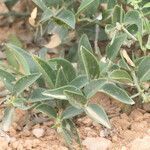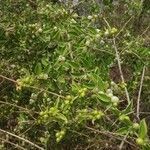Arbuste de 2 à 3 m. 50 de haut, toujours vert, entièrement glabre, en buisson épais, les rameaux peu rigides, parfois presque sarmenteux, restant longtemps verts ou verdâtres, presque toujours très épineux, rarement à aiguillons rares ou sans aiguillons; entre-noeuds allongés (1-5 cm.), les noeuds dilatés avec les cicatrices foliaires saillantes. Feuilles glauques, assez coriaces, d'ovales-lancéolées à étroitement lancéolées, très variables de dimensions (2.5/0.5; 2.6/1; 4.6/2.6; 8.2/2 cm), les feuilles des rameaux inférieurs ordinairement plus larges; pétiole très court (2-5 mm.); limbe terminé per une pointe spinulescente de 1 à 2 mm. de long; en général 2 paires de nervures latérales partant de la base ou presque; aiguillons allongés (1-4 cm.), cylindriques, très acérés d'un vertgrisâtre. Inflorescences [male] presque toujours en petites grappes ou épis (fleurs sessiles ou courtement pédicellées) axillaires d'une feuille, d'un aiguillon ou d'une bractée spinuliforme, parfois aussi en petites cymes pauciflores; fleurs de 3.5-4 mm. de haut; calice en sac 4-denté, un peu plus court que les pétales; pétales oblongs-lancéolés (4 x 1.5 mm); étamines à filet de 2 mm. et à anthère oblongue (1 mm. 5); rudimen d'ovaire subglobuleux. Fleurs [female] presque toujours isolées ou en glomérules 2-6-flores, sessiles ou courtement pédicellées et en plus grand nombre que les [male]; étamines (stériles) plus courtes; ovaire ovale ou globuleux, à peine contracté au sommet en style épais et derminé par un gros stigmate oblique et obscurément bilobé; 2 loges uniovulées. Baie peu charnue, blanche à maturité, globuleuse (1 cm. diam. env.); 1 ou 2 graines orbiculaires (6 mm. diam.) testa membraneux, jaunâtre; cotylédons orbiculaires profondément échancrés et auriculés à la base.
A much branched, tangled, evergreen shrub, 0.6–3 m. tall, with spines up to 3.5 cm. or more long, pale green, glabrous, slightly pubescent or hairy (in some Indian material); branches ± angled, often arching or scandent.. Leaves yellow-green; lamina elliptic or oblong to suborbicular, 1.4–5.7(–6.5) cm. long, 0.5–5.6 cm. wide, mucronate (the mucro small but sharp); venation rather prominent.. Flowers small, greenish, in small axillary clusters, often running into interrupted spikes at the ends of the twigs.. Berries green, turning white, similar to those of mistletoe, ± 0.6–0.8 cm. in diameter.. Seeds discoidal, black.. Fig. 1.
Shrub, dwarf shrub or climber, 0.4-8.0 m high. Leaves opposite, green, margins entire, apex mucronate; petioles flattened. Spines straight, 2 in axil of each leaf, up to 3.7 mm long. Bracts reduced. Calyx campanulate, 4-lobed and slightly 2-lipped. Petals originate at base of ovary, projecting beyond calyx. Stamens 4, alternating with petals; anthers exserted. Ovary rudimentary, on a small disc in centre of stamens. Flowering time Sept.-Nov. Fruit globose, ± 7 mm in diam. Seed with cotyledons cordate, flattened, deep brown.
A spiny evergreen shrub. It has many tangled branches. It grows 0.6 to 8 m tall. There are 4 spines at each pair of leaves. The spines are 3.5 cm long and sharp and straight. The leaves are yellow-green. The leaf blade is oblong and 1.4 cm wide by 6 cm long. The veins show up clearly. The flowers are small and green. They are produced in the axils of leaves in loose clusters. The fruit are small berries 6-8 mm across. They are green and turn white or yellow when ripe. The seeds are black and shaped like a disk.
Shrub or climber, 0.6-0.9 m or up to 8 m high. Branchlets terete or quadrate, armed with 4 spines at each node. Leaves opposite or subopposite, 2 pairs of lateral nerves from near base of lamina. Flowers greenish to yellowish.
Dioecious shrub or scrambler to 9 m with 4 straight thorns at each node. Leaves ± opposite, leathery, elliptic to suborbicular. Flowers 1-few in axillary glomerules or cymes, greenish to yellow.
Female flowers: staminoides with short filaments bearing sagittate sterile anthers; ovary up to 4–5 mm. long; 2–locular with 1–2 ovules per locule; stigma sessile.
Dioecious shrubs to 3(5) m. high, stems usually much branched, sometimes scrambling, bearing paired or solitary axillary straight spines.
Leaf–blades elliptic or oblong to suborbicular, 1·3–5·0 cm. long, 0·7–4·5 cm. wide, with stiff mucro at apex.
Male flowers: stamens inserted at base of rudimentary ovary, alternating with petals, anthers exserted.
Flowers small, in axillary clusters, often elongating, into interrupted spikes near ends of twigs.
Berries green, turning white, 0·6–0·8 cm. diameter, stigma persistent.
Young stems green, sometimes 4–angled, glabrous or pubescent.
Calyx campanulate, 4–toothed, 2–4 mm. long.
Corolla greenish, petals 4, 2–5 mm. long.
Seeds discoidal, dark brown.



